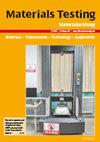Fe-8Ni-xZr氧化物弥散强化合金的压痕蠕变行为
IF 3.5
4区 材料科学
Q2 MATERIALS SCIENCE, CHARACTERIZATION & TESTING
引用次数: 0
摘要
摘要:通过室温压痕蠕变试验,研究了含Zr的两种氧化物弥散强化合金的蠕变行为。氧化物弥散强化合金为Fe-8Ni-xZr (x = 1和4 at)。%,分别为Zr-1和Zr-4合金),这些合金以前是通过机械合金化制造的;然后在1000 °C下通过等通道角挤压进行固结。压痕试验在最大载荷为100 mN,加载速率为300和400 mN min−1的条件下进行。采用Oliver-Pharr法计算硬度,测定蠕变位移、蠕变应变率、蠕变应力和应力指数n等蠕变性能。结果表明,Zr-4合金的硬度高于Zr-1合金。Zr-1合金的抗蠕变性能优于Zr-4合金。结果表明,合金的硬度和抗蠕变性能均与加载速率有关。并提出了一种可能的蠕变机理。虽然测试是在室温下进行的,但它们可以深入了解氧化物弥散强化合金微观组织在高温下对蠕变的影响。本文章由计算机程序翻译,如有差异,请以英文原文为准。
Indentation creep behavior of Fe–8Ni–xZr oxide dispersion strengthened alloys
Abstract This study was conducted to understand the creep behavior of two oxide dispersion strengthened alloys containing Zr as the alloying addition by performing indentation creep tests at room temperature. The oxide dispersion strengthened alloys were Fe–8Ni–xZr (x = 1 and 4 at.%, i.e., Zr-1 and Zr-4 alloys, respectively), which had been previously fabricated by mechanical alloying; followed by consolidation via equal channel angular extrusion at 1000 °C. The indentation tests were conducted under a maximum load of 100 mN with the loading rates at 300 and 400 mN min−1. The hardness was calculated by the Oliver–Pharr method, and the creep properties, such as the creep displacement, creep strain rate, creep stress, and stress exponent n, were determined. The results showed that the Zr-4 alloy was harder than the Zr-1 alloy. However, the creep resistance of the Zr-1 alloy was better than that of the Zr-4 alloy. It was further demonstrated that both the hardness and creep resistance depended on the loading rate. Moreover, a possible creep mechanism was proposed. Although the tests were performed at room temperature, they can provide insight into the effect of an oxide dispersion strengthened alloys microstructure on creep at higher temperatures.
求助全文
通过发布文献求助,成功后即可免费获取论文全文。
去求助
来源期刊

Materials Testing
工程技术-材料科学:表征与测试
CiteScore
4.20
自引率
36.00%
发文量
165
审稿时长
4-8 weeks
期刊介绍:
Materials Testing is a SCI-listed English language journal dealing with all aspects of material and component testing with a special focus on transfer between laboratory research into industrial application. The journal provides first-hand information on non-destructive, destructive, optical, physical and chemical test procedures. It contains exclusive articles which are peer-reviewed applying respectively high international quality criterions.
 求助内容:
求助内容: 应助结果提醒方式:
应助结果提醒方式:


